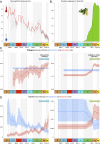The rise of angiosperms pushed conifers to decline during global cooling
- PMID: 33139543
- PMCID: PMC7682372
- DOI: 10.1073/pnas.2005571117
The rise of angiosperms pushed conifers to decline during global cooling
Abstract
Competition among species and entire clades can impact species diversification and extinction, which can shape macroevolutionary patterns. The fossil record shows successive biotic turnovers such that a dominant group is replaced by another. One striking example involves the decline of gymnosperms and the rapid diversification and ecological dominance of angiosperms in the Cretaceous. It is generally believed that angiosperms outcompeted gymnosperms, but the macroevolutionary processes and alternative drivers explaining this pattern remain elusive. Using extant time trees and vetted fossil occurrences for conifers, we tested the hypotheses that clade competition or climate change led to the decline of conifers at the expense of angiosperms. Here, we find that both fossil and molecular data show high congruence in revealing 1) low diversification rates, punctuated by speciation pulses, during warming events throughout the Phanerozoic and 2) that conifer extinction increased significantly in the Mid-Cretaceous (100 to 110 Ma) and remained high ever since. Their extinction rates are best explained by the rise of angiosperms, rejecting alternative models based on either climate change or time alone. Our results support the hypothesis of an active clade replacement, implying that direct competition with angiosperms increased the extinction of conifers by pushing their remaining species diversity and dominance out of the warm tropics. This study illustrates how entire branches on the Tree of Life may actively compete for ecological dominance under changing climates.
Keywords: competition; gymnosperms; macroevolution; paleoenvironment.
Copyright © 2020 the Author(s). Published by PNAS.
Conflict of interest statement
The authors declare no competing interest.
Figures



Comment in
-
Angiosperms versus gymnosperms in the Cretaceous.Proc Natl Acad Sci U S A. 2020 Dec 8;117(49):30879-30881. doi: 10.1073/pnas.2021186117. Epub 2020 Nov 13. Proc Natl Acad Sci U S A. 2020. PMID: 33188091 Free PMC article. No abstract available.
References
-
- Benton M. J., Progress and competition in macroevolution. Biol. Rev. Camb. Philos. Soc. 62, 305–338 (1987).
-
- Quental T. B., Marshall C. R., How the Red Queen drives terrestrial mammals to extinction. Science 341, 290–292 (2013). - PubMed
-
- Žliobaitė I., Fortelius M., Stenseth N. C., Reconciling taxon senescence with the Red Queen’s hypothesis. Nature 552, 92–95 (2017). - PubMed
-
- Sepkoski J. J., Jr, “Competition in macroevolution: The double wedge revisited” in Evolutionary Paleobiology, Jablonski D., Erwin D. H., Lipps J. H., Eds. (University of Chicago Press, Chicago, IL, 1996), pp. 211–255.
-
- Liow L. H., Reitan T., Harnik P. G., Ecological interactions on macroevolutionary time scales: Clams and brachiopods are more than ships that pass in the night. Ecol. Lett. 18, 1030–1039 (2015). - PubMed
Publication types
MeSH terms
Associated data
LinkOut - more resources
Full Text Sources

